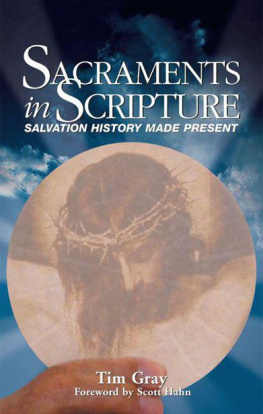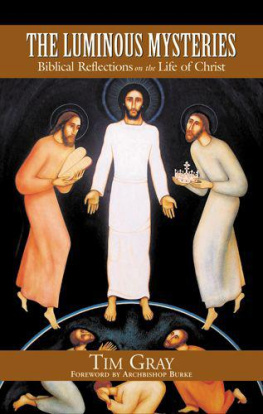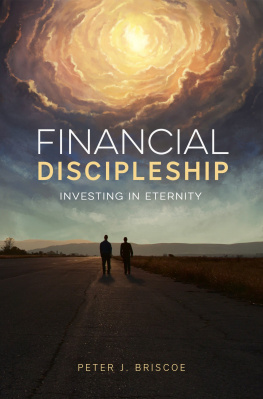Peter
Keys to Following Jesus
Tim Gray
Ignatius Press Augustine Institute
San Francisco Greenwood Village, CO
Ignatius Press Distribution
P.O. Box 1339
Fort Collins, CO 80522
Tel: (800) 651-1531
www.ignatius.com
Augustine Institute
6160 S. Syracuse Way, Suite 310
Greenwood Village, CO 80111
Tel: (866) 767-3155
www.augustineinstitute.org
All Scripture contained herein is from the
Revised Standard Version, Second Catholic Edition
2000 and 2006 by the Division of Christian Education of the National Council
of the Churches of Christ in the
United States of America. All rights reserved.
Cover Design: Devin Schadt
Cover Art:
Saint Peter
by Pompeo Girolamo Batoni (1708-1787)
Basildon Park, Berkshire, UK
National Trust Photographic Library / John Hammond
The Bridgeman Art Library
Copyright 2016, Ignatius Press-Augustine Institute
All rights reserved.
ISBN: 978-1-62164-070-7 (PB)
ISBN 978-1-68149-735-8 (EB)
Library of Congress Control Number 2016946129
Printed in Canada
Contents
Foreword
The overriding purpose of this book is to give a deep insight into the person of Peter within the time, places, and cultures in which he encountered Jesus and led the apostolic Church. It is also an attempt to set out the framework for a deeper personal encounter with Jesus, a more dynamic relationship with the Church, and a general plan for entering into discipleship and the New Evangelization.
Dr. Gray synthesizes insights of mind, heart, and spirit through his many scholarly and artistic interests and studies. Combining a remarkable knowledge of the language, geography, art, and ancient sites of both Israel and Rome, he weaves together the scriptural, traditional, and archaeological evidence of the life of Petergiving us a deep personal insight into the head Apostleas if we were really there.
One of Dr. Grays greatest strengths is his ability to unfold the deep historical, linguistic, cultural, spiritual, and scriptural richness of the many cryptic expressions and names found in the passages describing the first Apostle. As Dr. Gray considers each word or phrase, we see not only the Old Testament context out of which these words were spoken, but their deep spiritual significanceliterally and metaphorically. As he considers each major stage in the life of Peter, he moves effortlessly between etymological and grammatical studies, Old Testament history and prophecy, description of geographical sites and artistic masterpieces from the Catholic Tradition, and a deep spiritual appreciation of the Lordship of Jesus, and a seeming personal familiarity with Peter himself.
Two of the most revealing chapters are those on Peters primacy, in which Dr. Grays elucidation of the text reveals not only Jesuss trust in Peter, a man of many flaws, but also his desire to establish a Church with Peter as the rockthe foundationwith Jesus himself as the new temple. Dr. Grays study of the pertinent passages gives a solid foundation upon which to trust the Church as the living Body of Christ.
Though this book is not written as a formal apologetic for Petrine primacy, it presents compelling reasons for believing this to be the intention of Jesus in selecting Peter as the first Apostle and appointing him as his prime minister (by giving him the keys to the kingdom). I found Dr. Grays use of the phrase prime minister to refer to the appointed holder of the keys to the kingdom to be exceedingly enlighteningand also found his justification for doing so to be quite convincing. Dr. Gray begins by showing the parallels between the Davidic kingdom and the kingdom of Jesus. Just as David believed himself to be the steward of Gods kingdom (in his absence), so also Peter was to be the steward of Jesuss divine kingdom in his absence (see 1 Chr 29:10-11, 23).
Dr. Gray develops this theme by showing its presence in the Genesis narrative, where Joseph was made steward over the house (ha al bayyit ) of Pharaoh, giving Joseph authority over the kingdom in Pharaohs absence.
The final and most telling parallel occurs in the Book of Isaiah (22:18-22) in which Isaiah delivers an oracle to Shebna who was appointed prime minister of the housethe kingdomof Judah by King Hezekiah. Shebna proved himself unfaithful by not trusting in God and anticipating Israels fall to the Assyrians. Assuming he would die at the hands of the Assyrians, he constructed an elaborate tomb for himself. Since Shebna had not trusted God, God replaced him as prime minister by sending Isaiah the prophet with an oracle against Shebna and an appointment of Eliakim as his replacement:
I will thrust you from your office, and you will be cast down from your station. In that day I will call my servant Eliakim the son of Hilkiah, and I will clothe him with your robe, and will bind your belt on him, and will commit your authority to his hand; and he shall be a father to the inhabitants of Jerusalem and to the house of Judah. And I will place on his [Eliakims] shoulder the key of the house of David; he shall open, and none shall shut; and he shall shut, and non shall open . (Is 22:19-22, emphasis added)
Compare the last italicized line from the above oracle of Isaiah appointing Eliakim as new prime minister of the kingdom of Judah (the house of Judah) and the words of Jesus to appoint Peter as head of the Church: I will give you the keys of the kingdom of heaven, and whatever you bind on earth shall be bound in heaven, and whatever you loose on earth shall be loosed in heaven (Mt 16:19). The parallelism is so striking that it cannot be thought that this passage from Isaiah was not in the mind of Matthewand Jesusin using such words of appointment. If this is the case, then one cannot separate the intention of Jesus from the rest of the oracle of Isaiah that shows the keys to the kingdom are connected with an office and with the authority of God in that office. As Isaiah notes, I will thrust you from your office , and you will be cast down from your station... and I will commit your authority to his hand.
Though I have read many accounts of the significance of the keys to the kingdom, I consider Dr. Grays analysis to be one of the finest because it shows not only Jesuss intention to appoint Peter as head of the Apostles and head of the Church, but also to create an office of prime minister with his divine authority to be used in his absence. Inasmuch as Jesus and Matthew had the oracle of Isaiah in mind (which seems quite likely), then Jesus initiated an office of prime minister with divine authorityappointing Peter as the first holder of that office.
As noted above, Dr. Gray has a multifaceted purpose in writing this book, beyond establishing Peters position and office within the Church, which is the temple of Jesuss body. One of those purposes is to impart a theology of discipleship and evangelization based on seven interactions between Jesus and Peter (and sometimes the other disciples). Each interaction comes after a failure on the part of Peter (or the disciples) to understand or act properly. Dr. Gray sees these occasions of failure as intentional learning momentsnot only for Peter, but for anyone who aspires to be like him in discipleship and evangelization.
1. In one of Peters finest hours, when he distinguishes himself from the other Apostles and comes to meet Jesus on the water, Peter takes his eyes off of Jesus and looks at the rough waters beneath him, and begins to sink. Dr. Gray takes Jesuss instruction to Peter as a primary tenet of discipleship: be constant, childlike, and bold in your faith; keep your eyes fixed on Jesus; and remember that fear undermines faith.
2. Immediately after witnessing the miracle of the loaves and fishes, the Apostles begin to feel quite proud of Jesuss success, at which point Jesus warns them to avoid the leaven of the Pharisees. Dr. Gray explains that leaven means pride or puffed up and even corruption, from which he draws the lesson that true disciples should not seek success and prestige in the world (the leaven of the Pharisees) but rather imitate the humble service of Jesus.












